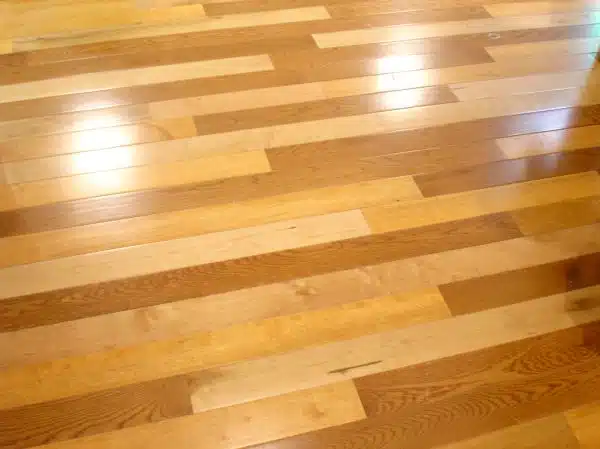Flooring is an essential aspect of any home. It sets the tone for the entire decor, and it’s often a significant investment in both time and money. When it comes to flooring options, carpet and hardwood are two of the most popular choices among homeowners. However, choosing between these two flooring types can be a daunting task, as each has its unique strengths and weaknesses.
Carpet provides warmth, comfort, and insulation to any room. It’s soft underfoot and absorbs sound, making it an ideal choice for bedrooms or living rooms where noise reduction is necessary. On the other hand, hardwood flooring offers durability and a timeless beauty that’s unmatched by any other type of flooring. It’s easy to clean and maintain, making it perfect for high traffic areas such as hallways or entryways. In this article, we’ll compare carpet vs. hardwood flooring based on several factors such as cost, maintenance requirements, durability, aesthetics, eco-friendliness, and health concerns to help you make an informed decision for your home.
Cost Comparison
When it comes to flooring, cost is a crucial factor. Comparative pricing between carpet and hardwood flooring will help homeowners make an informed decision. In general, hardwood flooring is more expensive than carpet. The installation of hardwood floors requires more labor and time, which adds to the overall cost. Conversely, carpet installation is relatively easy and takes less time.
Budgeting considerations are also important when comparing the costs of carpet versus hardwood flooring. While the initial cost of installing hardwood floors may be higher, they can last for decades with proper maintenance. Carpet, on the other hand, has a shorter lifespan and may need to be replaced more frequently. Additionally, choosing a high-quality carpet with better materials and construction can increase its durability but also raises the price.
As a flooring expert, it’s essential to understand that different factors affect pricing between these two types of flooring. Homeowners should consider their budgeting needs and the long-term costs before deciding between carpet or hardwood flooring. Next, we will explore another critical aspect of this debate: durability – which lasts longer?
Durability: Which Lasts Longer?
Cost is certainly an important factor when deciding between carpet and hardwood flooring, but durability is equally essential. A longevity comparison between the two materials reveals that hardwood flooring lasts much longer than carpet, making it a more cost-effective option in the long run. Hardwood floors have a lifespan of up to 100 years with proper maintenance, while carpets only last around 10 years before needing replacement.
Wear and tear analysis further highlights the difference in durability between carpet and hardwood flooring. Carpets are prone to wear and tear due to foot traffic, spills, and stains. They also tend to accumulate dirt, dust, and allergens over time. On the other hand, hardwood floors are resistant to scratches, dents, and stains. They are easy to clean and maintain with regular sweeping or vacuuming.
In addition to their superior durability, hardwood floors also add value to your home. They are considered a premium choice in flooring options and can increase your property’s resale value. However, it’s important to note that hardwood floors require more upfront investment compared to carpets. While the initial cost may be higher for installing hardwood floors, their longevity makes them a better investment in the long run.
Moving forward into our next section about maintenance requirements for carpet, it’s important to consider the extra effort needed for upkeep of this material compared to hardwood floors.
Maintenance Requirements For Carpet
Like all flooring options, carpet requires regular maintenance to keep it looking and performing its best. One of the most important aspects of carpet maintenance is cleaning. Dirt, dust, and other debris can become trapped in the fibers of your carpet, leading to discoloration and even damage over time. To prevent this from happening, it is recommended that you vacuum your carpet at least once a week with a high-quality vacuum cleaner.
Another key factor in maintaining your carpet is stain prevention. While spills are inevitable, there are steps you can take to minimize the risk of permanent staining. First and foremost, act quickly when a spill occurs. Blot up as much of the liquid as possible using a clean cloth or paper towel before applying any cleaning solution. Avoid rubbing or scrubbing the area, as this can push the stain deeper into the fibers.
Regular cleaning and stain prevention are essential for keeping your carpet looking great for years to come. By following these simple guidelines, you can help ensure that your carpet remains a beautiful and functional part of your home décor. In the subsequent section, we will explore some of the maintenance requirements for hardwood flooring – another popular flooring option for homeowners looking for durability and style.
Maintenance Requirements For Hardwood
Hardwood flooring will require regular cleaning, such as sweeping and vacuuming, to maintain its appearance. Waxing and polishing can also be done to keep the floor looking shiny and new. Moisture protection is important to ensure the longevity of the hardwood flooring and refinishing or sanding may be necessary for deep cleaning and repair. Ultimately, hardwood flooring requires regular upkeep to maintain its beauty and value.
Cleaning
When it comes to the maintenance requirements for hardwood flooring, cleaning is an essential aspect that cannot be ignored. Keeping your hardwood floors clean not only enhances their appearance but also prolongs their lifespan. One of the best ways to clean hardwood floors is through steam cleaning. This method involves using hot water vapor to sanitize and disinfect your floors without causing any damage to the wood. Steam cleaning effectively removes dirt, grime, and bacteria from your floors, leaving them with a sparkling shine.
Another important aspect of maintaining hardwood flooring is spot removal. Spills and stains are inevitable in any household, and if not removed promptly, they can cause irreversible damage to your floors. To prevent this from happening, it’s advisable to have a good quality stain remover on hand at all times. When dealing with spills or stains, act quickly by soaking up as much liquid as possible with a cloth before applying the stain remover.
Vacuuming is another effective way of maintaining your hardwood floors. Regular vacuuming helps remove dirt and debris that can scratch or damage the surface of your floors over time. It’s important to use a vacuum cleaner that has a soft-bristled attachment or one that’s specifically designed for hardwood flooring. Additionally, using doormats at entry points can help prevent dirt from being tracked onto your floors in the first place.
In conclusion, regular cleaning is essential for maintaining the beauty and longevity of your hardwood flooring. Incorporating methods such as steam cleaning and spot removal into your routine will go a long way in preventing damage caused by spills and stains. Additionally, vacuuming regularly with the right equipment will help ensure that your floors remain free from scratches and other forms of damage caused by dirt and debris. With proper maintenance, you can enjoy the natural beauty of your hardwood flooring for many years to come!
Waxing/Polishing
As a flooring expert, it’s important to discuss the different methods of maintaining hardwood flooring. In addition to cleaning, another method that can be used is waxing or polishing. Waxing involves applying a layer of wax over the surface of your floors, which helps protect them from scratches and other forms of damage. The benefits of waxing include enhancing the natural beauty of your floors by giving them a shiny appearance and adding an extra layer of protection.
While waxing is an effective method for maintaining hardwood floors, polishing may not be the best option. Polishing involves using a chemical solution to remove scratches and scuffs from the surface of your floors. However, this method can be damaging in the long run as it removes layers of finish with each use, eventually leaving your floors vulnerable to damage without any protection. Additionally, polishing can leave behind streaks and a cloudy appearance.
In conclusion, while both waxing and polishing can be used for maintaining hardwood flooring, it’s important to consider their benefits and drawbacks before choosing which method to use. Waxing provides an extra layer of protection while enhancing the natural beauty of your floors, while polishing may cause more harm than good in the long run. It’s essential to prioritize the longevity and durability of your hardwood flooring when choosing maintenance methods so that you can enjoy its beauty for many years to come.
Aesthetics: Which Looks Better?
When it comes to aesthetics, choosing between carpet and hardwood flooring ultimately boils down to personal preference. Both options have their own unique charm that can complement different interior design trends. Hardwood flooring is known for its timeless beauty and versatility, making it a popular choice among homeowners who want a chic and elegant look for their homes. On the other hand, carpet adds warmth and texture to any space, making it an ideal choice for those who want a cozy and inviting ambiance.
To determine which type of flooring suits your aesthetic preferences best, consider the overall look and feel you want to achieve in your home. If you’re aiming for a sleek and sophisticated vibe, hardwood flooring is an excellent option that can elevate any room’s aesthetic appeal. On the other hand, if you’re after a more relaxed vibe that prioritizes comfort over formality, then carpet may be the better option for you.
In summary, both carpet and hardwood flooring have their own charm that can add value to your home’s overall aesthetic appeal. Whether you prefer the timeless beauty of hardwood or the cozy warmth of carpeting will depend on your personal style and preferences. Ultimately, the key is to choose what makes you happy as you’ll be living with your decision long-term.
Comfort And Insulation: Benefits Of Carpet
Moving on from aesthetics, the next important factor to consider when choosing between carpet and hardwood flooring is comfort and insulation. While carpet may be more comfortable to walk or sit on, it may not be the most hygienic choice. Carpets tend to trap dust, allergens, and pet dander, which can cause respiratory problems for those with allergies or asthma. Hardwood floors, on the other hand, are easier to clean and maintain, making them a better option for people who prioritize cleanliness over comfort.
Insulation is another crucial aspect to consider when deciding between carpet and hardwood flooring. Carpet provides excellent insulation by keeping heat inside a room during colder months. This makes it ideal for areas that experience extreme weather conditions. However, people with allergies may find that their symptoms worsen in rooms with carpeted floors since carpets tend to trap dust mites and other allergens. Hardwood floors provide less insulation but are still effective in keeping a room warm during winter months.
When choosing between carpet and hardwood flooring, it is essential to weigh the benefits of both options carefully. Deciding whether comfort or hygiene is more important will help you make an informed decision that suits your needs best. While hardwood floors may not be as comfortable as carpets, they provide a cleaner environment for people with allergies or respiratory problems. In contrast, carpets offer better insulation but require regular cleaning to maintain cleanliness standards. In the next section, we’ll explore timeless beauty: benefits of hardwood flooring that go beyond functionality alone.
Timeless Beauty: Benefits Of Hardwood
Hardwood flooring offers a timeless and natural aesthetic. It is also extremely durable and can last for many years with proper maintenance. In comparison to other flooring materials such as carpet, hardwood flooring may be more expensive, but it offers an excellent return on investment. In terms of cost-effectiveness, hardwood flooring is much more cost-efficient in the long run due to its longevity and minimal maintenance costs. It is also easy to repair and refinish, making it a great option for those who want a floor that will stand the test of time. Hardwood flooring is an ideal choice for anyone looking to add a classic and timeless beauty to their home.
Aesthetics
When it comes to choosing the right flooring, homeowners are often faced with the dilemma of carpet vs. hardwood. Both options have their pros and cons, but when it comes to aesthetic appeal, hardwood flooring takes the cake. Hardwood floors have a timeless beauty that can elevate any home décor, offering a warm and inviting atmosphere. Unlike carpet, which can quickly become outdated or stained, hardwood floors offer a classic look that never goes out of style.
Hardwood floors come in a variety of colors and finishes, allowing homeowners to choose the perfect one that suits their style and taste. With proper maintenance, hardwood floors can last for decades without losing their shine or elegance. On the other hand, carpet tends to wear out over time and requires frequent cleaning to maintain its appearance. Moreover, carpets tend to trap dust and allergens more easily than hardwood floors, making them less suitable for people with allergies.
In conclusion, if you’re looking for a flooring option that offers timeless beauty and aesthetic appeal, then hardwood flooring is the way to go. Not only does it provide an elegant look that never goes out of style, but it’s also durable and easy to maintain. Carpet may be cozy underfoot but it lacks durability and doesn’t offer the same level of sophistication as hardwood flooring. Ultimately, your choice between carpet vs. hardwood will depend on your personal preferences and lifestyle needs.
Durability
When it comes to choosing a flooring option, durability is a significant factor to consider. Hardwood flooring is known for its strength and durability, making it an excellent investment for your home. Unlike carpets that tend to wear out over time, hardwood floors have a long lifespan and can last for decades with proper maintenance. This longevity makes hardwood floors a cost-effective solution in the long run.
One of the pros of hardwood flooring is that it can be refinished multiple times throughout its life expectancy. Refinishing involves sanding down the top layer of the hardwood floor and applying a new finish, which restores the floor’s shine and removes any scratches or dents. This process can extend the life of your hardwood floors even further, making them an even more worthwhile investment.
However, one con of hardwood flooring is that it may not be suitable for high-traffic areas as it can scratch or dent easily under heavy use. It’s also essential to note that while hardwood floors are durable, they still require regular maintenance to keep them in good condition. This includes sweeping or vacuuming regularly and avoiding water exposure as much as possible. By doing so, you can ensure that your hardwood floors remain beautiful and sturdy for years to come.
Cost-Effectiveness
Cost-effectiveness is a significant factor when it comes to choosing the right flooring option for your home or rental property. While carpet may seem like an affordable choice initially, it may not be the most cost-effective option in the long run. In comparison, hardwood flooring is known for its durability and can last for decades with proper maintenance. This longevity makes hardwood floors a worthwhile investment, especially for rental properties where frequent replacements can be costly.
One of the key benefits of hardwood flooring’s cost-effectiveness is its longevity. Unlike carpets that tend to wear out quickly, hardwood floors have a long lifespan and can withstand heavy use over time. This makes them an excellent option for high-traffic areas in homes or rental properties. Additionally, refinishing hardwood floors multiple times throughout their life expectancy can further extend their lifespan and make them look as good as new.
In terms of long-term savings, investing in hardwood flooring can save you money in the long run. While the initial cost may be higher than other flooring options such as carpet, the durability and low maintenance costs make it a more cost-effective choice over time. By choosing hardwood flooring, you’ll avoid frequent replacements and repairs associated with other types of flooring options, ultimately saving you money in the long run while enjoying timeless beauty.
Eco-Friendliness Of Carpet
Did you know that carpet is the most popular flooring choice in the United States, with over 50% of households having at least one room covered in this material? However, carpet has been criticized for its environmental impact. Let’s take a closer look at the eco-friendliness of carpet.
Recycling options: Many carpets are made from synthetic materials that cannot be easily recycled. However, there are now more eco-friendly options available, such as those made from recycled plastic bottles or natural fibers like wool. Additionally, some manufacturers have established recycling programs to turn old carpet into new products.
Material sourcing: The production of synthetic carpets requires the use of petroleum-based products and chemicals, which can have a negative impact on the environment. But with sustainable practices becoming more mainstream, many manufacturers are now sourcing materials responsibly and using safer chemicals in their production processes.
Energy efficiency: Carpet has a higher insulation value than hardwood flooring, which means it can help keep your home warmer during colder months and reduce energy consumption. This not only benefits the environment but can also save you money on heating bills.
As an expert in flooring, I would advise anyone looking for an eco-friendly option to consider all aspects of carpet production and disposal before making a decision. While there are certainly concerns around the impact of certain types of carpets on the environment, there are also many steps being taken to make this flooring option more sustainable overall.
Next up, we will explore the eco-friendliness of hardwood flooring and how it compares to carpet in terms of environmental impact.
Eco-Friendliness Of Hardwood
When it comes to flooring options, eco-friendliness is an important factor to consider. Hardwood flooring has the potential to be sustainable if sourced responsibly. Sustainable sourcing entails ensuring that the trees used for hardwood are not taken from natural forests or protected areas. Instead, they should come from managed forests where new trees are planted as old ones are harvested. This practice ensures that there is no net loss of trees and that the forest ecosystem remains intact.
In addition to responsible sourcing, hardwood flooring can also contribute to reducing carbon footprint. Trees absorb carbon dioxide during their growth, and this carbon is stored in their wood even after they’ve been cut down for use in construction. When hardwood floors are installed, the carbon remains locked away within them for many years, helping to reduce the amount of carbon in the atmosphere. Additionally, some manufacturers use renewable energy sources like solar or wind power during production, further reducing their environmental impact.
Overall, when considering eco-friendliness and sustainability of flooring options, hardwood can be a good choice if sourced responsibly and manufactured with a focus on reducing its carbon footprint. With sustainable sourcing practices and careful consideration throughout the manufacturing process, hardwood floors can be an environmentally conscious choice for homeowners.
As we have seen so far, there are several advantages to using hardwood flooring over carpeting. In addition to being more durable and easier to clean, hardwood flooring has the potential to be more eco-friendly than carpeting. However, it’s worth noting that there are still some health concerns associated with certain types of hardwood finishes and adhesives used during installation. These concerns will be explored in detail in the subsequent section about health concerns with carpeting.
Health Concerns With Carpet
Carpet is a popular flooring choice for its comfort and aesthetic appeal. However, carpet hygiene is a concern that should not be overlooked. Carpets can easily accumulate dust, dirt, and other allergens over time. These particles can trigger allergies and asthma in individuals who are sensitive to them. Vacuuming regularly can help remove these particles, but it may not be enough to completely eliminate them.
Furthermore, carpets can also harbor bacteria and mold if they become moist or damp. This can lead to unpleasant odors and pose a health risk to individuals with weakened immune systems or respiratory issues. To prevent this from happening, it is important to maintain proper ventilation and moisture control in the room where the carpet is installed.
Despite these concerns, there are ways to mitigate the health risks associated with carpet. Regular cleaning and maintenance, such as steam cleaning or shampooing, can help remove built-up allergens and bacteria. Additionally, investing in low-pile or short-fiber carpets can make cleaning easier and reduce the likelihood of buildup. For those with severe allergies or asthma, however, hardwood flooring may be a better option.
As we have seen, there are valid health concerns associated with carpet flooring due to its potential for harboring allergens and bacteria. Nonetheless, proper maintenance can significantly reduce these risks. In the next section, we will explore health concerns related to hardwood flooring so that you may make an informed decision about which type of flooring best suits your needs.
Health Concerns With Hardwood
Despite the numerous advantages of hardwood flooring, it is not without its health concerns. One such concern is flooring allergies. Some individuals may experience allergic reactions to certain types of wood used in flooring. This can lead to symptoms such as sneezing, coughing, and even skin rashes. It is important for homeowners to be aware of their allergy status before investing in hardwood flooring.
Another potential health concern with hardwood flooring is wood toxicity. Certain woods used in flooring can emit volatile organic compounds (VOCs) that can cause respiratory problems and other health issues. Homeowners should consider selecting low-VOC or no-VOC options when choosing their hardwood floors to minimize these risks.
To further reduce the risk of health concerns associated with hardwood flooring, homeowners should take proper care and maintenance measures such as regularly cleaning and dusting their floors. Additionally, they should consider using area rugs or mats in high traffic areas to prevent excessive wear and tear on the floors.
- When considering wood toxicity, it is important to note that some exotic woods like Brazilian cherry contain more toxins than domestic woods like oak.
- Homeowners should research the specific type of wood used in their flooring before making a purchase.
- Another factor to consider is the finish applied during installation.
- Oil-based finishes tend to have higher VOC levels than water-based finishes.
Moving forward, it’s important for homeowners to weigh the benefits and potential risks associated with hardwood flooring before making a decision. In the next section, we will explore the installation process for carpeting and how it compares to hardwood floors.
Installation Process For Carpet
Carpet installation is a process that can be done easily, but it requires careful planning and attention to detail. Before starting the installation process, consider the tips and tricks that will ensure your carpet looks great and lasts for years to come. One common mistake to avoid is not measuring the area correctly. This can lead to buying too much or too little carpet, resulting in waste or additional expenses.
Another factor to consider when installing carpet is the cost. Several factors affect the overall cost of installation, including the type of carpet you choose, the size of your space, and whether you hire a professional installer or do it yourself. Budget-friendly options are available for those who want to save money on their flooring project. However, keep in mind that cheap carpets may wear out faster than higher-quality options.
When installing carpet, always start with a clean surface by removing any old flooring and ensuring that the subfloor is level. Next, use a tack strip around the perimeter of the room to secure the edges of your new carpet. Then, roll out your carpet and trim it to fit around obstacles such as doorways or stairs. Finally, use a power stretcher tool to stretch your carpet tightly across the room and finish with molding strips along walls or transitions between rooms.
Transition: While installing carpet can be an affordable option for many homeowners, others prefer hardwood floors for their durability and timeless beauty. If this sounds like you, read on for essential information about installing hardwood flooring in your home.
Installation Process For Hardwood
Now that we have explored the installation process for carpet, it is time to delve into the installation process for hardwood flooring. Many homeowners wonder whether they should attempt a DIY installation or hire a professional. While it may be tempting to save money by doing it yourself, hardwood flooring is not an easy material to work with and can be challenging to install correctly. If you are not experienced in flooring installation, it may be best to leave it to the professionals.
The cost of materials for hardwood flooring is generally higher than that of carpet. However, hardwood has a longer lifespan than carpet and can increase the resale value of your home. When considering the cost of materials, keep in mind that while carpet may be cheaper upfront, it will need to be replaced more frequently than hardwood. Hardwood flooring can last for decades with proper care and maintenance.
In summary, when it comes to installing hardwood flooring, hiring a professional is often the best choice if you want high-quality results. While the cost may be higher initially, hardwood flooring has a longer lifespan and can increase the resale value of your home. When comparing costs between hardwood and carpet materials, keep in mind that while carpet may seem cheaper upfront, it will need to be replaced more often than hardwood. In our next section on resale value comparison between carpet and hardwood flooring, we’ll take a closer look at how each material affects your home’s overall value.
Resale Value Comparison
When it comes to comparing the resale value of carpet and hardwood flooring, it’s important to consider a few factors. Firstly, it’s essential to note that the real estate market is constantly evolving, and recent trends can significantly impact your home’s resale value. Secondly, there are several tips for comparing these two types of flooring that can help you make an informed decision.
In recent years, the demand for hardwood flooring has increased significantly due to its durability, longevity, and aesthetic appeal. It’s no secret that buyers are willing to pay more for homes with high-quality hardwood floors. On the other hand, carpets have received some criticism due to their susceptibility to wear and tear over time, which decreases their resale value.
When comparing the resale value of carpet and hardwood flooring, one tip is to consider the buyer’s preferences in your area. For example, if you’re selling a home in a colder climate where homeowners prefer a cozy environment, then carpets may be more desirable than hardwood floors. Conversely, if you’re selling a home in a warmer climate where buyers prefer cooler temperatures indoors or have pets that shed frequently – then hardwood floors might be a better option. Ultimately, understanding market trends and buyer preferences will help you make an informed decision when choosing between carpet or hardwood floors for your home’s resale value.
As we now know how crucial it is to consider market trends and buyer preferences when comparing carpet and hardwood flooring – let us move onto selecting the right flooring type for your home.
Choosing The Right Flooring For Your Home
When it comes to choosing the right flooring for your home, there are certain factors that you need to keep in mind. Both carpet and hardwood flooring have their own set of pros and cons, so it ultimately comes down to personal preference and practicality. Here are some things to consider before making a decision:
Durability factors: Hardwood flooring is known for its durability and can last for decades if properly maintained. On the other hand, carpets tend to wear out over time and require replacement every few years. If you have pets or young children, hardwood may be a better option as it is easier to clean up spills and messes.
Installation costs: Hardwood flooring generally has a higher installation cost than carpet, but it can also increase the value of your home in the long run. Carpet installation is typically cheaper, but you will also need to factor in the cost of replacing it every few years.
Maintenance: Both carpet and hardwood require regular maintenance to keep them looking their best. Hardwood needs to be cleaned with specific products to avoid damaging the wood, while carpets require regular vacuuming and occasional deep cleaning.
Comfort: Carpet provides a softer surface underfoot than hardwood, making it more comfortable for sitting or lying down on. This can be especially important if you have young children who like to play on the floor.
Environmentally friendly options: If you are concerned about the environmental impact of your flooring choice, there are eco-friendly options available for both carpet and hardwood flooring. Consider using sustainable materials such as bamboo or cork for your hardwood floors or opting for recycled materials when selecting your carpet.
Overall, when choosing between carpet and hardwood flooring, consider factors such as installation costs, durability factors, maintenance requirements, comfort level, and eco-friendliness. By taking these into account alongside personal preferences such as style and aesthetics, you can make an informed decision that will serve you well for years to come.
Conclusion
Carpet and hardwood flooring are both popular options for homeowners, but which one is better? It ultimately comes down to personal preferences and lifestyle factors. When it comes to cost, carpet is typically less expensive than hardwood. However, hardwood has a longer lifespan and can increase the resale value of your home. Maintenance requirements also differ between the two, with carpet requiring regular vacuuming and deep cleaning while hardwood needs occasional polishing.
In terms of aesthetics, some may prefer the cozy feel of carpet while others may appreciate the timeless elegance of hardwood. The installation process also varies, with carpet being relatively easy to install while hardwood requires professional installation. Ultimately, it’s important to weigh the pros and cons of each option before making a decision on which flooring to choose for your home.
As a flooring expert, it’s important to note that there is no clear winner when it comes to carpet vs. hardwood flooring. Both options have their own unique benefits and drawbacks. It’s up to the homeowner to consider their budget, lifestyle factors, and personal preferences when making a decision. No matter which option you choose, investing in quality flooring will improve the overall look and feel of your home for years to come.
Image Credits
- “Multi-Color Hardwood Flooring” by merfam (featured)





























